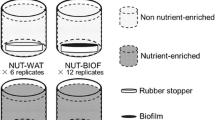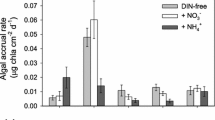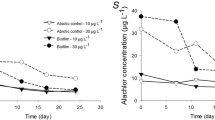Abstract
We present results from in vitro flask and flume experiments using freshwater biofilms sourced and cultivated from a mine-impacted stream in North Yorkshire, UK. Flask experiments showed rapid uptake of Zn from the water column into biofilms. This uptake was not light dependant and suggests that chelation of Zn by negatively charged functional groups in extracellular polymeric substances (EPS) secreted within the biofilm are the key sink for Zn. Solid state analysis of the biofilm from the mesocosm system by scanning electron microscopy highlights the presence of calcite precipitates within the EPS, which may provide another sink for Zn. Long-term monitoring of flume systems showed area-adjusted removal rates of ≈0.2 g Zn m−2 day−1, which is consistent with many other biologically-mediated mine water treatment systems. Diel (24 h) fluctuations in pH and Zn were observed over a 96 h intensive sampling period in the flumes. Practical considerations for establishing and maintaining biofilms under controlled conditions are also highlighted; these include regulation of light intensity and maintenance of flowing, low nutrient status waters.
Zusammenfassung
Ergebnisse von Versuchen in Flaschen und Messrinnen mit Biofilmen werden vorgestellt, welche aus einem bergbaulich belasteten Bach in North Yorkshire, UK entnommen und kultiviert wurden. Die Flaschenversuche zeigten eine schnelle Aufnahme von Zink aus der Wassersäule in die Biofilme. Die Aufnahme war nicht lichtabhängig; dies deutet darauf hin, daß Chelation von Zn durch negativ geladene funktionale Gruppen stattfand und daß die Hauptsenke für Zn extrazelluläre polymerische Substanzen (EPS) waren, welche im Biofilm abgesondert wurden. Festkörperanalyse des Biofilms des Mesokosmossystems mittels Rasterelektronenmikroskopie zeigte im EPS ausgeschiedenen Kalzit, der als weitere Senke für Zn dienen könnte. Langzeitbeobachtung von Rinnensystemen ergab flächenbezogene Entzugsraten von ≈ 0.2 g Zn m−2 Tag−1, übereinstimmend mit vielen anderen biologisch vermittelten Bergbauwasseraufbereitungsanlagen. Schwankungen von pH und Zn im Tagesgang wurden während einer 96 h langen, intensiven Beprobungsperiode in den Rinnen beobachtet. Praktische Überlegungen für die Ansiedlung und Erhaltung von Biofilmen werden hervorgehoben; sie umfassen neben anderem die Regulierung der Lichtintensität und die Aufrechterhaltung von fließendem, nährstoffarmem Wasser.
Resumen
Se presentan resultados obtenidos de experimentos en frascos y en canales artificiales usando biofilms de agua fresco y cultivados desde una corriente impactada por la minería en North Yorkshire, UK. Los experimentos en frascos mostraron una rápida retención de Zn dentro de los biofilms. Esta retención no fue dependiente de la luz y sugiere la quelación de Zn por grupos funcionales cargados negativamente en sustancias poliméricas extracelulares (EPS) excretadas dentro del biofilm. El análisis del biofilm presente en el sistema mesocosmos mediante microscopía electrónica de barrido, mostró precipitados de calcita dentro del EPS, que podría proveer otro lugar para el depósito de Zn. El monitoreo a largo plazo de los experimentos en canales artificiales mostró velocidades de remoción de ≈ 0.2 g Zn m-2día-1, que es consistente con otros sistemas de tratamiento de aguas mediados por actividad biológica. Se observaron fluctuaciones diarias (24 h) en pH y Zn dentro de un período de muestreo intensivo de 96 h en los canales artificiales. Se resaltan consideraciones prácticas para el establecimiento y el mantenimiento de los biofilms; estas incluyen la regulación de la intensidad de la luz y el mantenimiento del flujo de aguas con bajos nutrientes.
摘要
淡水生物膜取自英国北约克郡受矿井影响的河流。本文进行了淡水生物膜体外培养瓶和水槽实验。实验结果表明,生物膜能够迅速吸收试验柱中的锌。该吸收吸不具光感特征,表明生物膜内分泌的胞外聚合物(EPS)的带负电官能团对锌具有螯合吸收作用,此处构成了锌吸收的重要汇点。同时,利用电子显微镜进行围隔实验的生物膜固态分析,观察到胞外聚合物(EPS)内方解石沉淀生成;该处成为锌吸收的另一个汇点。长期水槽监测实验表明,锌的面积校正去除率为0.2 g Zn m−2 day−1,与许多其它矿山废水生物处理效果一致。通过96小时水槽试验密集采样,分析了水槽pH值和锌浓度的昼夜(24小时)波动规律。生物膜维护需要格外关注光照强度和低养分水流流动性等实际因素。.







Similar content being viewed by others
References
Alabaster JS, Lloyd R (1980) Water quality criteria for freshwater fish. Butterworths, London
Armitage PD, Bowes MJ, Vincent HM (2007) Long-term changes in macroinvertebrate communities of a heavy metal polluted stream: the river Nent (Cumbria, UK) after 28 years. River Res Appl 23:997–1015
Backstrom M, Borjesson E, Karlsson S (2002) Diurnal variations of abiotic parameters in a stream, recipient for drainage water in Ranstad, southwest Sweden. J Environ Monit 4:772–777
Bissett A, Reimer A, De Beer D, Shirasishi F, Arp G (2008) Metabolic microenvironmental control by photosynthetic biofilms under changing macroenvironmental temperature and pH conditions. Appl Environ Microbiol 74:6306–6312
Brick CM, Moore JN (1996) Diel Variation of Trace Metals in the Upper Clark Fork River, Montana. Environ Sci Technol 30:1953–1960
Decho AW (2010) Overview of biopolymer-induced mineralization: What goes on in biofilms? Ecol Eng 36(2):137–144
Elzinga EJ, Reeder RJ (2002) X-ray absorption spectroscopy study of Cu2+ and Zn2+ adsorption complexes at the calcite surface: Implications for site-specific metal incorporation preferences during calcite crystal growth. Geochim Cosmochim Acta 66:3943–3954
Environment Agency (2013) Interactive Maps. Accessed 15 Oct 2013 http://maps.environment-agency.gov.uk/wiyby/wiybyController?ep=maptopics&lang=_e
Flemming HC, Wingender J (2010) The biofilm matrix. Nat Rev Microbiol 8:623–633
Ford DC, Williams PW (2007) Karst geomorphology and hydrology. Unwin Hyman, London
Gandy CJ, Jarvis AP (2012) The influence of engineering scale and environmental conditions on the performance of compost bioreactors for the remediation of zinc in mine water discharges. Mine Water Environ 31:82–91
Gillespie WB, Hawkins WB, Rodgers JH, Cano ML, Dorn PB (1999) Transfers and transformations of zinc in flow-through wetland microcosms. Ecotox Environ Safe 43:126–132
Gozzard E, Mayes WM, Potter HAB, Jarvis AP (2011) Seasonal and spatial variation of diffuse (non point) source zinc pollution in a historically metal mined river catchment, UK. Environ Pollut 159:3113–3122
Jarvis AP, Mayes WM (2012) Prioritisation of abandoned non coal mine impacts on the environment. Environment Agency Report SC030136/R14, Bristol, UK
Jones A, Rogerson M, Greenway G, Mayes WM (2013) Mine water geochemistry and metal flux in a major historic Pb-Zn-F orefield, the Yorkshire Pennines, UK. Environ Sci Pollut Res 20(11):7570–7581
Kalin M (1998) Biological polishing of zinc in a mine waste management area. In: Geller W, Klepper H, Salomons W (eds) Acidic mining lakes: acid mine drainage. Limnology and Reclamation, Springer, pp 321–334
Mayes WM, Johnston D, Potter HAB, Jarvis AP (2009a) A national strategy for identification, prioritisation and management of pollution from abandoned non-coal mine sites in England and Wales. I. Methodology development and initial results. Sci Total Environ 407:5435–5447
Mayes WM, Potter HAB, Jarvis AP (2009b) Novel approach to zinc removal from circumneutral mine waters using pelletised recovered hydrous ferric oxide. J Hazard Mater 161:512–520
Mayes WM, Potter HAB, Jarvis AP (2010) Inventory of aquatic contaminant flux arising from historic metal mining in England and Wales. Sci Total Environ 408:3576–3583
Mayes WM, Davis J, Silva V, Jarvis AP (2011) Treatment of zinc-rich acid mine water in low residence time bioreactors incorporating waste shells and methanol dosing. J Hazard Mater 193:279–287
McGeer JC, Szebedinszky C, McDonald DG, Wood CM (2000) Effects of chronic subleathal exposure to waterbourne Cu, Cd or Zn in rainbow trout. 1: iono-regulatory disturbance and metabolic costs. Aquat Toxicol 50:231–243
Moore LR, Durand JR, Strickland F (2013) Copper removal from mine effluents: from lab to field evaluations. Mine Water Environ 32:239–246
Morris JM, Nimick DA, Farag AM, Meyer JS (2005) Does biofilm contribute to diel cycling of Zn in high ore creek, Montana? Biogeochemistry 76:233–259
Nimick DA, Cleasby TE, Mccleskey RB (2005) Seasonality of diel cycles of dissolved trace-metal concentrations in a Rocky Mountain stream. Environ Geol 47:603–614
Nimick DA, Gammons CH, Cleasby TE, Madison JP, Skaar D, Brick CM (2003) Diel cycles in dissolved metal concentrations in streams: Occurrence and possible causes. Water Resour Res 39:1247
Nimick D, Gammons CH, Parker SR (2011) Diel biogeochemical processes and their effect on the aqueous chemistry of streams: a review. Chem Geol 283:3–17
Nuttall CA, Younger PL (2000) Zinc removal from hard, circumneutral mine waters using a novel closed bed limestone reactor. Water Res 34:1262–1268
Oren AH, Kaya A (2006) Factors affecting adsorption characteristics of Zn2+ on two natural zeolites. J Hazard Mater B131:59–65
Pedley HM, Rogerson M (2010) In vitro investigations of the impact of different temperature and flow velocity conditions on tufa microfabric. Geol Soc Spec Publ 336:193–210
Pedley M, Rogerson M, Middleton R (2009) Freshwater calcite precipitates from in vitro mesocosm flume experiments: a case for biomediation of tufas. Sedimentology 56:511–527
Rogerson M, Pedley M, Wadhawan JD, Middleton R (2008) New insights into biological influence on the geochemistry of freshwater carbonate deposits. Geochim Cosmochim Acta 72:4976–4987
Rogerson M, Pedley HM, Middleton R (2010) Microbial influence on macroenvironment chemical conditions in alkaline (tufa) streams: perspectives from in vitro experiments. Geol Soc Spec Publ 336:65–81
Saunders P (2012) Can Tufa Mg/Ca Ratios be Used as a Palaeoclimate Proxy? PhD Thesis, Univ of Hull, UK
Scott DT, McKnight DM, Voekler BM, Hrncir DC (2002) Redox processes controlling manganese fate and transport in a mountain stream. Environ Sci Technol 36:453–459
Song Y, Fitch M, Burken J, Nass L, Chilukiri S, Gale N, Ross C (2001) Lead and zinc removal by laboratory-scale constructed wetlands. Water Environ Res 73:37–44
Sutherland I (2001) Biofilm exopolysaccharides: a strong and sticky framework. Microbiology 147:3–9
Taylor LN, McGeer JC, Wood CM, McDonald DG (2009) Physiological effects of chronic copper exposure to rainbow trout (Oncorhynchus mykiss) in hard and soft water: evaluation of chronic indicators. Environ Toxicol 19:2298–2308
Tercier-Waeber M-L, Hezard T, Masson M, Schäfer J (2009) In situ monitoring of the diurnal cycling of dynamic metal species in a stream under contrasting photobenthic biofilm activity and hydrological conditions. Environ Sci Technol 43:7237–7244
Tsukamoto TK, Miller GC (1999) Methanol as a carbon source for microbiological treatment of acid mine drainage. Water Res 33:1365–1370
van Hullebusch ED, Zandvoort MH, Lens PNL (2003) Metal immobilisation by biofilms: mechanisms and analytical tools. Rev Environ Sci Biotechnol 2:9–33
Warren LA, Haack EA (2001) Biogeochemical controls on metal behaviour in freshwater environments. Earth Sci Rev 54:261–320
Warrender R, Pearce NJG, Perkins WT, Florence KM, Brown AR, Sapsford DJ, Bowell RJ, Dey M (2011) Field trials of low-cost reactive media for the passive treatment of circumneutral metal mine drainage in Mid-Wales, UK. Mine Water Environ 30:82–89
Whitfield AK, Elliott M (2002) Fishes as indicators of environmental and ecological changes within estuaries: a review of progress and some suggestions for the future. J Fish Biol 61:229–250
Zachara JM, Cowan CE, Resch CT (1991) Sorption of divalent metals on calcite. Geochim Cosmochim Acta 55:1549–1562
Acknowledgments
We are grateful for a University of Hull Anniversary Scholarship for AJ. Chemical analyses were greatly assisted and facilitated by Bob Knight. Thanks to Mike Dennett for help with installation of the electrodes and data logging software. Thanks also to Mark Anderson and Kim Rosewell for laboratory assistance.
Author information
Authors and Affiliations
Corresponding author
Electronic supplementary material
Below is the link to the electronic supplementary material.
Rights and permissions
About this article
Cite this article
Jones, A., Rogerson, M., Greenway, G. et al. Zinc Uptake from Circumneutral Mine Drainage in Freshwater Biofilms: New Insights from In Vitro Experiments. Mine Water Environ 34, 295–307 (2015). https://doi.org/10.1007/s10230-015-0325-9
Received:
Accepted:
Published:
Issue Date:
DOI: https://doi.org/10.1007/s10230-015-0325-9




